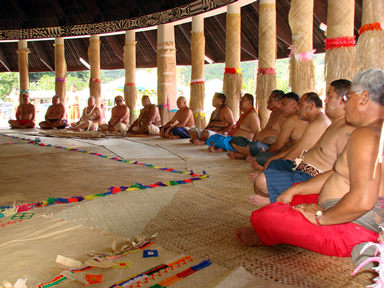
Courtesy of National Park Service
The National Park of American Samoa areas on three islands are part of a larger chain of 17 islands and two atolls that comprise the Samoan Archipelago. The land is divided in two recognized political territories, the United States Territory of American Samoa and Samoa, an independent country 15 times larger than American Samoa. American Samoa is approximately 76 square miles and when counting 200 miles of surrounding waters, the territory is approximately the size of Oregon. The islands are humid and rainy most of the year with average temperatures around 85 degrees Fahrenheit. The United States Government does not own the land in the National Park of American Samoa because of the Samoan traditional practice of a communal land system. The National Park Service leases it from the Samoan village councils.
Although a relatively small territory, American Samoa has a long cultural history dating back nearly 3,000 years. The Samoan culture is considered the oldest in all of Polynesia, an area in the southern and central Pacific Ocean including over 1,000 islands. People likely first migrated to the Samoan Islands from southeast Asia by water routes thousands of years ago. Archeologists confirmed the presence of humans on the islands in 1960 when many pieces of pottery from at least 2700 years ago were discovered. The pottery bore a resemblance to the patterns used by a Pacific culture called “Lapita,” a group from the Bismarck Archipelago.
Due to a lack of recoverable artifacts, researchers have pointed to a long gap of approximately 800 years in the archeological record of Samoa. The belief is that this period, often referred to as the “Samoan Dark Ages,” is actually a time when Samoan culture flourished and developed significantly. The underground archeological site Fatumafuti on the island of Tutuila provides some clues of this development. Outlines of houses and structures remain and remnants of tools as old as 700 years found at the site indicate when Samoan people first started using stone tools to carve wood and develop a more complex society. While visitors today cannot easily view this site, they should check with the visitor center to find archeological sites to visit.
Also of particular importance to the development of culture in American Samoa are the somewhat mysterious tia seu lupe or star mounds. These irregularly shaped, raised platforms constructed of earth are suspected to have been used in rituals involving trapping pigeons by chiefs, but they likely contain greater significance not yet fully understood. The use of these mounds decreased when Europeans arrived in Samoa bringing Christian practices. Today, some mounds are visible on Ta’u Island.
Probably the biggest reason people make the long journey to American Samoa is to experience the indescribable beauty of the territory’s oceans, coral reefs, beaches, and cliffs. The park has well mapped driving routes for visitors to get a good overview of the landscape of tropical rainforests containing over 700 species of trees and plants on a drive from Pago Pago to the north coast. For people who would prefer to see nature up-close, Ofu Island offers amazing snorkeling opportunities to view some of the over 250 coral species and over 950 fish species that live in the waters around American Samoa. The island also contains stunning views above water for hikers wishing to take in the seascapes from immaculate shorelines.
Neighboring Tutuila Island offers walks that take visitors to historic World War II sites. Although not technically within the boundaries of the park, Blunts and Breakers Point Gun Emplacements highlight the significant role American Samoa played during World War II while offering stunning views. Both sites are listed in the National Register of Historic Places. The Blunts Point Trail is a moderately difficult hike allowing hikers to see two of the cannons that protected Pago Pago Harbor during the war.
The history and natural environment of American Samoa come together to produce a distinctive culture known as Fa’asamoa or the Samoan Way. Samoan society is also very communal and rooted in one’s family. Sunday is traditionally the day of rest in most villages. To gain a truly intimate understanding of the life and people of American Samoa, the park created a Homestay Program to provide visitors with a short-term immersion in Samoan culture. The National Park Service facilitates, but does not administer the program. This program can be a great way to visit the park as long as visitors remain flexible and make their expectations of the visit clear to their hosts. To stay with a host family, visit the national park’s website Homestay page or email the park at e-mail us.
Today, the National Park of American Samoa retains much of its natural and cultural diversity due to the preservation and interpretation efforts of the park and Samoan residents. Although quite removed from most other units of the National Park System, the park is the perfect destination for an adventurer looking to experience Samoan culture, tropical rainforests, coral reefs, fruit bats, and ancient volcanoes.
The visitor center offers exhibits that show the close relationship between Samoans and nature. Exhibits at roadside pull-offs provide additional information about the islands.
For families and children, the park offers the Junior Ranger Program. A digital copy of the National Park Service’s Junior Ranger Activity Book can be found here or in hardcopy at the park’s visitor center.
Last updated: August 18, 2017
